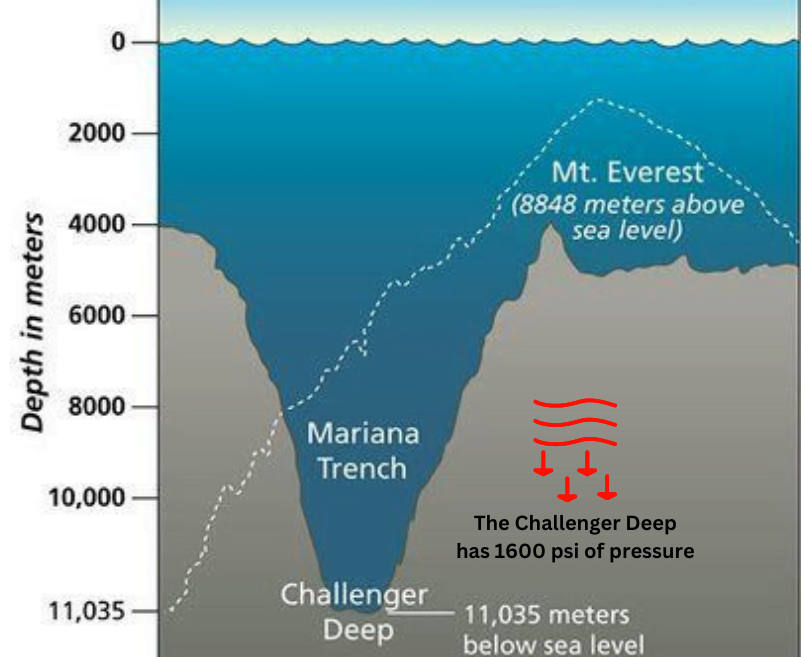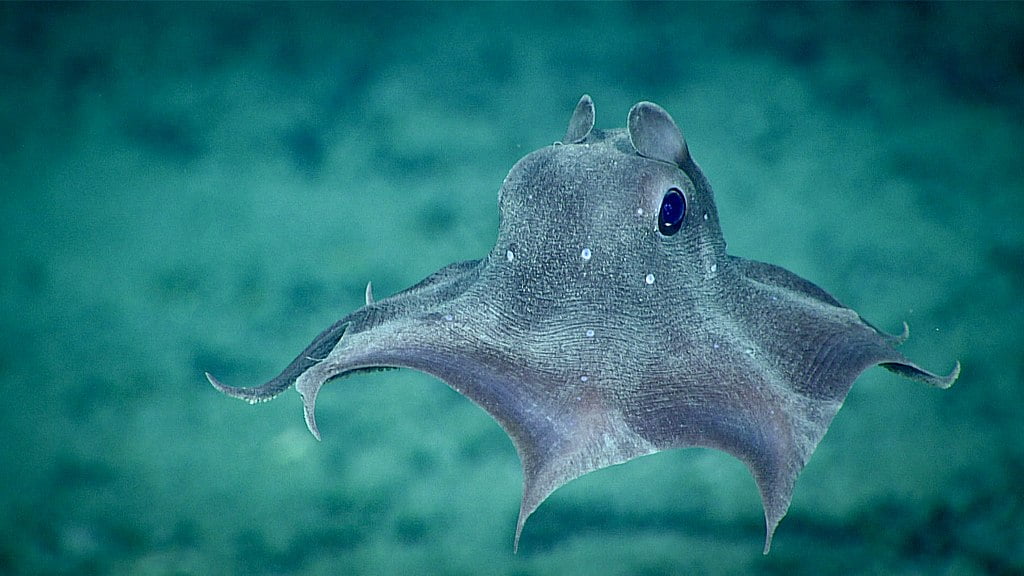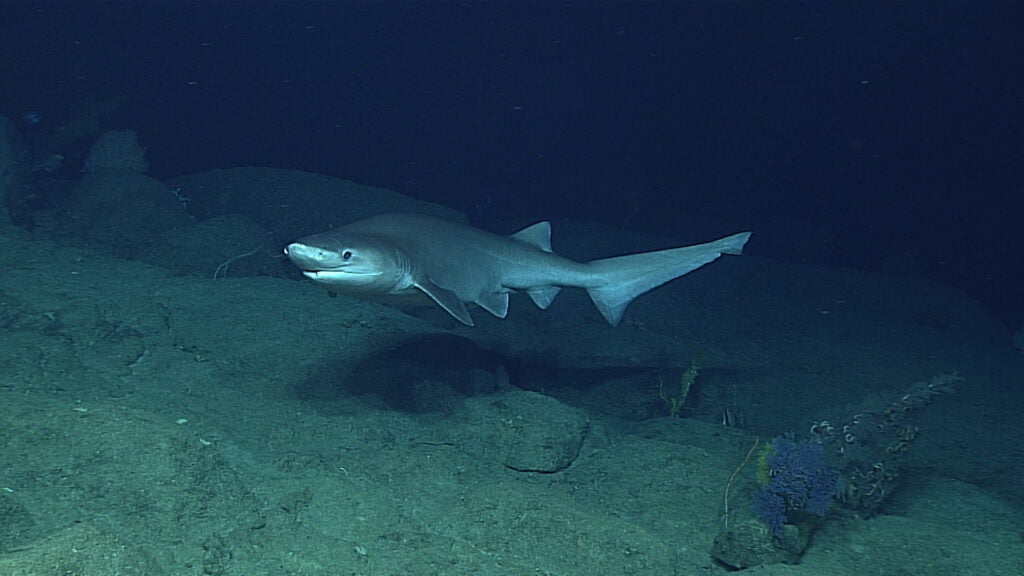If you’ve ever gone snorkeling or swimming in ocean, you might have noticed that your ears start to feel a tingling sensation. That’s because the deeper you go, the more pressure is pushing down on your body. The deep ocean is one of the most extreme environments on Earth. As you go deeper, the pressure increases rapidly, quickly reaching levels that would crush a human.
But why deep ocean has high pressure like this? The quick answer is – The ocean’s high pressure comes from mass and gravity – more mass means more force. Now imagine all that water sitting on top of you as you go deeper in the ocean. The deeper you go, the more water mass piles up above. At the deepest point in the ocean, the Challenger Deep in the Mariana Trench, the water pressure is a whopping 1,086 bar – equivalent to having 50 jumbo jets piled on you head!
It might seem strange that water can cause so much pressure. Interestingly Dumbo Octopus is a deep sea animal that lives at the extreme depths of 10,000 feet unaffected! But why does this anomaly happen? Why deep ocean has high pressure? There are some interesting science reasons behind it. Let us dive deep and get the answers out!
How Does Pressure Work Anyway?
I know physics is boring. But stay with us here! Understanding a little bit about pressure will help all of this make sense.
Pressure is basically just the amount of force applied over a certain area. So the more force, and the smaller the area, the higher the pressure. Simple right?
Think about the ocean. As you go deeper, you have all the weight of the water above pushing down into the water below. The deeper you go, the more water there is above you, pressing down. The pressure increases with depth because there are more and more tons of water weighing down from above.
Now think about standing on the beach versus diving deep underwater. On land, you feel atmospheric pressure of about 14.7 pounds per square inch pushing down on your body from the weight of the air above you. Not too bad.
But in the ocean, the pressure story is very different. As you descend below the surface, you have all the weight of the water above you pressing down. The deeper you go, the more water there is exerting force from above – translating into rapidly increasing pressure.
Pressure Increases with Depth

- The ocean is very deep. The average depth is about 12,100 feet or 3,700 meters. Every 33 feet (10 meters) you descend from water surface adds roughly one additional atmosphere (14.7 psi) of pressure. So at 330 feet underwater, you’re experiencing over 10 times the pressure you feel on land! It quickly escalates from there.
- But in some places, like the Mariana Trench, it is over 36,000 feet or 11,000 meters deep. That’s a lot of water bearing down from above! At the Mariana Trench or Challenger Deep, there is approximately 16,000 PSI of pressure. That’s over 1000 times the air pressure that you feel right now! It’s hard to even imagine how much pressure that is. Just know it’s a crazy amount!
- If you could somehow descend to the bottom of the Mariana Trench, you would experience the equivalent of having 50 jumbo jets stacked on top of you!
- Without protective equipment, the human body cannot withstand such bone-crushing force. No wonder the pressure gets so intense at the bottom.
Pressure on the Bottom of the Ocean

Challenger Deep in the Mariana Trench is around 11,000 Meters below the sea surface – that’s deeper than flipping Mount Everest upside down! the bottom of the Mariana Trench has 1600 psi of pressure. PSI is a unit for measuring pressure. But what does this mean to us in the real world? Well, it’s hard to imagine. The pressure at the bottom of the deepest point in the ocean would feel like 100 adult elephants standing on your head!
Consequences of High Pressure in Ocean
Here are some reasons how the extreme pressure in the deep ocean changes things:
It Crushes Submarines
The pressure at depth is strong enough to crush most submarines like tin cans. Engineers have to design super strong submarines just to be able to withstand a dive to the deep ocean. If not, the sub would implode from the insane pressure!
It Creates Amazing Creatures
Lots of cool ocean creatures have adapted to the high pressure environment. For example, blobfish look like blobs because the pressure at depth keeps their bodies firm. But when brought to the surface, the lack of pressure causes them to turn into blobby goo! Deep-sea creatures have evolved incredible adaptations to survive under high-pressure conditions.
It has Created First Lifeform on the Earth
According to a research of Stanford University– In the beginning the more stable temperatures of the ocean’s depths allowed the burgeoning life forms to make the best use of limited oxygen supplies. The only place where temperatures were consistent was in the deep ocean. In a world of limited oxygen, the newly evolving life needed to be as efficient as possible and that could only be achieved in the relatively stable depths. That’s why the first lifeform on the Earth appeared in the deep ocean.
It Shapes the Landscape
The pressure is so strong it actually compresses sediments on the seafloor into solid rock! It’s also strong enough to bend tectonic plates and create undersea mountains and trenches. Pretty amazing that water can shape rock like that.
It Regulates Our Climate
The deep ocean plays a crucial role in regulating the Earth’s climate. It acts as a vast reservoir for heat and carbon dioxide, absorbing a significant amount of both. Deep ocean pressure drives a crucial global ocean circulation pattern called the thermohaline circulation or ocean conveyor belt. This system transports heat and salt around the globe, moderating climate.
It Makes the Ocean Unexplored
The extreme pressure makes the deep ocean one of the most inhospitable places for humans. We can’t go very deep without being crushed! It’s still largely unexplored because of this danger. According to NOAA– As of 2023, only 24.9% of the global seafloor had been mapped with modern high-resolution technology. Rest 75.1% is still unexplored.
Creatures of the Deep Oceans: 6 Extreme Animals
From soaring heights to dark depths, life finds ingenious ways to take root in the most intense places. What crazy creatures actually thrive where the pressure would pulp a person?
1. Dumbo Octopus – These cuties flap their ear-like fins to soar over the seafloor at depths of 3,000-4,000 meters. Their jelly-like bodies can readily compress and change shape. While most octopuses have an external shell, the Dumbo octopus does not. Not having a hard exoskeleton means its body can bend and change shape much more easily to equalize pressure on all sides

2. Sperm Whale – Diving over 1,000 meters to hunt giant squid. How? Sperm whales have flexible rib cages that compress at depth along with body oils to help withstand pressure changes.
3. Giant Tubeworms – Lacking gas-filled spaces that would implode, tubeworms have soft bodies that simply compress. They withstand insane pressures near hydrothermal vents.
4. Anglerfish – These freaky fish can still open wide to grab prey despite the compression at 2,000+ meter depths. how? Anglerfish have gelatinous bodies that are less dense than water. This composition allows them to be buoyant, reducing the impact of the high-pressure of deep ocean.

5. Six-gilled Shark – They spend most of their time sluggishly roaming the deep ocean floor below 900 meters. Their oily liver helps them achieve neutral buoyancy.

6. Xenophyophores – These giant single-celled protozoans cover the abyssal seafloor. Unique proteins allow their cells to still function when compressed by gigatons of water.
Pursuing the Deep Ocean: 3 Ways We Explored the Depths
While the crushing pressure creates challenges, human ingenuity (and curiosity) have driven us to go deeper into the abyss. Here are some key innovations and expeditions that unlocked the deep ocean:
- Bathyscaphes – Before advanced submersibles, these early vessels made the first forays past 6,000 meters. Their observation of the Challenger Deep seafloor in 1960 kicked off the deep-sea race.
- Alvin Submarine – This stalwart deep sub explored the first hydrothermal vents in 1977 and let scientists actually see the alien life thriving there, despite the immense pressure.
- James Cameron’s Dive – In 2012 the filmmaker and explorer squeezed into a tiny submersible and plunged 11,000 meters solo into the Challenger Deep trench, returning amazing footage and inspiration.
FAQs: Why deep ocean has high pressure?
Still confused or curious? Here are answers to some common questions about Why deep ocean has high pressure.
Q:How deep do you have to go before the pressure is a problem?
A: For humans, pressure starts becoming an issue at depths as shallow as 30 meters. The pressure at 30 meters is 2 atmospheres, twice the pressure at the surface. At 100 meters depth, the pressure is 4 atmospheres. Commercial divers generally can’t go deeper than 200 meters without special equipment. Beyond 300 meters it gets really challenging, and the deepest scuba dive ever was to 332 meters!
Q: Why is the pressure so high in the deep ocean?
A: The ocean’s high pressure comes from mass and gravity – more mass means more force. Now imagine all that water sitting on top of you as you go deeper in the ocean. The deeper you go, the more water mass piles up above.
Q:How sperm whale survive the extreme deep ocean pressure?
A: Yes! Sperm whales can dive over 1,000 meters into the abyss to hunt giant squid. Their ribcages have been shown to collapse under pressure at depth, while other adaptations allow them to thrive in the deep ocean environment. Badass whales!
Q: What is the pressure in the deepest ocean?
A: At the deepest point in the ocean, the Challenger Deep in the Mariana Trench, the water pressure is a whopping 1,086 bar – equivalent to having 50 jumbo jets piled on you head.
Q:Why does pressure increase if we go deep into the ocean?
A: The pressure in a fluid (such as water) increases with depth because the weight of the fluid above exerts a force on the layers below. This force is distributed equally in all directions, including upwards, downwards, and sideways. As a result, the deeper we go, the more layers of water are pressing down on us, and the higher the pressure becomes
Q: What technology do we have to handle the pressure?
A: Engineers use spherical shapes and exotic materials like titanium to allow vessels to withstand pressure. And for humans, they’ve developed pressurized diving suits and even liquid breathing to alleviate pressure issues. We’re making progress to access more of the deep blue sea!
The Ocean’s Depths Still Hold Many Mysteries
While we have discussed a good amount about deep ocean pressure today, we still have so much to learn about the deepest parts of the sea. It’s estimated over 75% of the ocean floor remains unmapped and unexplored! The immense pressure makes it one of the least known habitats on Earth.
But new technology is allowing us to dive deeper, mapping the seafloor in new detail and discovering crazy new species. Who knows what mysteries still lurk in the ocean’s extreme depths?
So while physics and pressure may seem boring at first, they create wild landscapes and creatures that we hope sparked your imagination today. Stay curious!!

